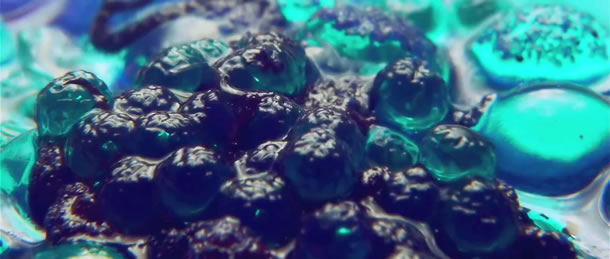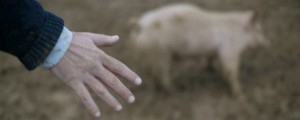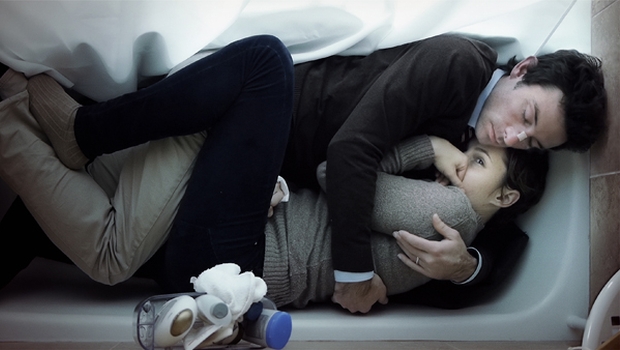I have to give a bit of a preface to this review. This film deeply resonated with me but it may not do so for you. Upstream Color demands a great deal from its audience. You have to be in the middle of an unusual Venn diagram to truly enjoy this film. The more of the following list you are into, the more I would recommend it to you:
Biology, Ecology, Parasitology, Science Fiction, The Philosophy and Literature of Transcendentalism, Eastern Religions, Buddhism, Samsara, Film Theory, and Art Films. (So the GPPs and rating are more of a reflection of my appreciation for the film rather than any kind of broad recommendation.)
The movie begins in a rather jarring manner. The imagery is confusing and the narrative is unclear. It takes some effort to struggle through early plot points. We are fed information about a parasite that might be a drug that might play a role in a criminal endeavour. Confusion is visually expressed with transitions of in- and out-of-focus shots. The power of the parasite seems to make people highly suggestible but also amplifies memory and imagination.
The parasite grows and writhes around in its host until it’s placed in a pig. Those that come in contact with this parasite are permanently changed by it. They develop a kind of psychic bond to the pig. As the film progresses we see that the bond is actually much more profound. The emotional content of the characters becomes much simpler and more primal but no less deeper or intense.
Even the love portrayed between the main characters takes on this color. What binds their marriage together comes from a place that is immemorial and feral. Sex, feelings, and reactions take on a kind of direct animalistic quality that is plain, raw, and almost accidental.
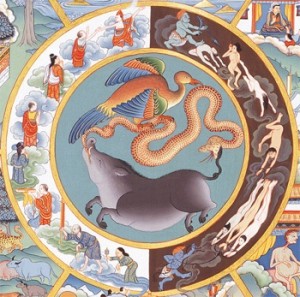
The importance of the imagery of Upstream Color rapidly draws from a library of symbols and ideas. The most prominent of these is Samsara or the endless spinning of existence. The Wheel of Life from Eastern religions has at its core three obstacles to enlightenment that are represented by the pig, the bird, and the snake. The pig represents ignorance and spawns the other two representing desire and anger respectively.
The main characters embody this never-ending cycle through their actions in the narrative. Separately, they begin in ignorance of their condition, become bound to one another, and finally express violent aggression. In the cosmology of faiths that carry the imagery associated with Samsara, the only escape is enlightenment. Whatever spritual content we impose on our actions in this revolution will have its consequence in the next turn of the wheel.
Recurring visual themes of circles, threes, and spinning or turning are prominent in many shots. The recyle sign on the dumpster, the wedding rings, and the Volvo (Latin for “I roll.”) are a few of the visual markers expressing Samsara and the cyclicality of nature. The thematic tension between natural and artificial are also posed in harsh contrast.
An important literary allusion the film makes is to Thoreau’s Walden. Transcendentalism was deeply influenced by Eastern beliefs and finds a neat parallel to many of the themes in the film. Transcendence, according to proponents, is achieved through a recognition of nature’s connection with the individual. This is supposed to dissolve the individual into a oneness with nature. It is an attempt to remember what we can have without the distractions of civilization. It is an attempt to become aware of unity; to repair the whole by rebinding the parts; to forgive the arrogance that smashed it to pieces in the first place.
This idea of interconnectivity in nature is expressed in systems analysis as an emergent property. That is to say, the whole is more than just the sum of its parts. It takes all of your cells and tissues and organs working together to make you work. If even one of your vital bits stopped working the whole would be no more. The dynamics of simple things, when layered, create a bewildering array of complexity. That complexity may acquire a life of its own.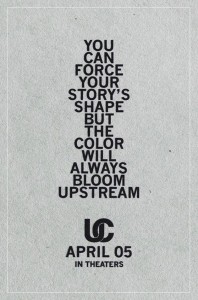
We disconnect ourselves from nature and each other because it is too difficult to chart the relationships between the pieces. This is true to the point that we can confuse an impossible number of connections for chaos; we can feel lost and alone because of it. As much as we may try, analytical intellect alone can never bring us spirituality.
The staggering inputs and outputs of biological systems in nature create a repeating web of interconnectivity. The transcendentalists imagined these relationships as a mystical spirituality taking the form of a primal longing, hard wired into us, and only momentarily forgotten. Eastern philosophies illustrated the endless turning of the world as a rolling wheel that is only bound by the truth of impermanence.
Imagine a film that can convey these ideas and more. I can comfortably say that this is the best film experience I have ever had. After the credits rolled on Shane Carruth’s Upstream Color, I hadn’t felt that satisfied at a film’s ending since The Shawshank Redemption. I’m quite confident I’ll watch this movie many more times and get something new out of it with each go. I hope you do too.



